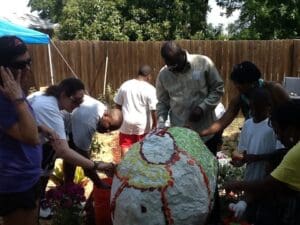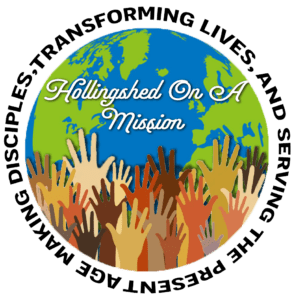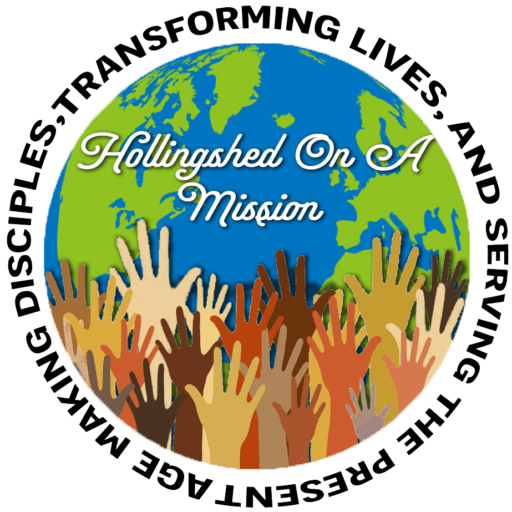In my previous blog, “Why Prison Ministry Matters: A Message from Dr. Sandra R. Stanley,” I discussed the cracks in our judicial system, particularly the disproportionate number of Black individuals incarcerated in Texas compared to other races and states. This reflects deeper societal and institutional issues that demand our attention. This month, I want to continue that conversation by delving into evangelism, defining it and reflecting on how repairing our understanding of it can restore the Church’s spiritual foundation. Evangelism is the cornerstone of our faith, carrying God’s message into the world—one person, one community, one story at a time. Throughout my 30 years as an Evangelism Director in both Texas and Georgia, I’ve often been asked, “What is evangelism?” I always welcome this question because it allows me to share that evangelism is the act of proclaiming the Good News of Jesus Christ—His life, death, resurrection, and the salvation He offers.
 However, just as often, I am asked a follow-up question: “But what does that mean for my church?” My answer is simple: evangelism is the outward expression of the Church’s inward transformation. When we truly encounter the Gospel, it brings hope, healing, and a deep sense of purpose that cannot be contained. As the prophet Jeremiah declared, “His word is in my heart like a fire, a fire shut up in my bones. I am weary of holding it in; indeed, I cannot” (Jeremiah 20:9 NIV). Fire is difficult to contain; it spreads rapidly and ignites everything it touches. I love when a long-time friend of mine, a retired fire department chief, shares fascinating stories about fires. He explained that when water is sprayed on flames, it doesn’t just extinguish the fire; it turns into steam, absorbing heat and cooling the air around it. This process is known as the latent heat of vaporization and helps slow the fire’s spread. In the same way, when a church becomes cold and unengaged, it can water down evangelism and outreach efforts, hindering the transformative power of the Holy Spirit.
However, just as often, I am asked a follow-up question: “But what does that mean for my church?” My answer is simple: evangelism is the outward expression of the Church’s inward transformation. When we truly encounter the Gospel, it brings hope, healing, and a deep sense of purpose that cannot be contained. As the prophet Jeremiah declared, “His word is in my heart like a fire, a fire shut up in my bones. I am weary of holding it in; indeed, I cannot” (Jeremiah 20:9 NIV). Fire is difficult to contain; it spreads rapidly and ignites everything it touches. I love when a long-time friend of mine, a retired fire department chief, shares fascinating stories about fires. He explained that when water is sprayed on flames, it doesn’t just extinguish the fire; it turns into steam, absorbing heat and cooling the air around it. This process is known as the latent heat of vaporization and helps slow the fire’s spread. In the same way, when a church becomes cold and unengaged, it can water down evangelism and outreach efforts, hindering the transformative power of the Holy Spirit.
Without the fire of God’s love actively moving through the congregation, the church becomes a place of ritual and routine, rather than a living, breathing body of believers on a mission. Just as fire needs fuel and oxygen to burn brightly, evangelism requires passionate hearts and a willingness to engage in the mission of reaching the lost. I’ve witnessed firsthand how, for some, the word “evangelism” is often downplayed as simply preaching on street corners or handing out tracts. “Evangelism” comes from the Greek euangelion, meaning “good news” or “gospel” (Strong’s Concordance, Greek 2098 – euangelion). While these are certainly valid ways to share the Good News of Jesus Christ, evangelism in the Black Church runs much deeper—especially for me, having grown up in the South, where it’s not just about preaching; it’s about being a living testimony within the community. Evangelism is deeply rooted in our history, nurtured by our faith, shaped by our resilience, and embedded in our communities. Oftentimes, it’s our ongoing pursuit of justice and liberation that drives it.
Yet, the widespread misconception of evangelism has created a crack in our spiritual foundation. Historically, the Church has been a sanctuary of hope, refuge, and empowerment. Evangelism, in this context, has always been—and continues to be—a powerful tool for proclaiming freedom, spiritually, socially, and politically, advocating for the liberation of all God’s people. As Dr. James H. Cone powerfully says in his book, A Black Theology of Liberation, “The Bible is a revolutionary book…the Church is the social agency for the liberation of the oppressed. It is not the task of the Church to go along with the world, but to challenge the world.” This view challenges us to rethink evangelism not as a passive act but as a radical force for justice. Like fire, it carries transformative power that should flow through our words, actions, and witness as we share God’s love with others. Historically, the Church has been where the Black community found solace and strength in the face of adversity during times of oppression, injustice, and struggle. The Church became a powerful force for social justice.
Building Evangelism Across Cultural Divides
 From the days of slavery to the Civil Rights Movement and into the present, particularly in light of recent political decisions that continue to affect the most vulnerable, the Black Church has been more than just a place of worship. However, I realize that not every culture sees evangelism through the same lens. I am reminded of my 21 years of pastoring at North Park CME Church in Dallas, Texas, where I was blessed to partner ecumenically with pastors from various denominations and racial backgrounds. Through these relationships, we united for a common mission to transform lives and communities, despite our differences. Through collaborative leadership, we came together with a unified vision to serve our community and advance the work of ministry. Two pastors who stand out in particular are Rev. Stan Copeland, pastor of Lovers Lane United Methodist Church (UMC)—a multi-million-dollar ministry—and Rev. Joy Daley of St. Thomas the Apostle Episcopal Church.
From the days of slavery to the Civil Rights Movement and into the present, particularly in light of recent political decisions that continue to affect the most vulnerable, the Black Church has been more than just a place of worship. However, I realize that not every culture sees evangelism through the same lens. I am reminded of my 21 years of pastoring at North Park CME Church in Dallas, Texas, where I was blessed to partner ecumenically with pastors from various denominations and racial backgrounds. Through these relationships, we united for a common mission to transform lives and communities, despite our differences. Through collaborative leadership, we came together with a unified vision to serve our community and advance the work of ministry. Two pastors who stand out in particular are Rev. Stan Copeland, pastor of Lovers Lane United Methodist Church (UMC)—a multi-million-dollar ministry—and Rev. Joy Daley of St. Thomas the Apostle Episcopal Church.
Located less than 10 minutes from my church, both churches became significant supporters of our outreach efforts through the Hallelujah House Outreach Ministry Center, Inc. They contributed to initiatives such as our weekly food bank ministry and community prayer garden. Lovers Lane UMC generously donated to our food bank each month, providing nourishment for hundreds of families in our community. St. Thomas the Apostle Episcopal Church contributed flowers for our prayer garden and donated supplies to help build a handicap-accessible ramp for the outreach center. Our prayer garden was named in honor of our beloved daughter, the late Kennedi Iman Hollingshed. We also partnered with K.B. Polk Elementary School, whose art teacher and students came to build a beautiful mosaic for the garden and assisted with planting flowers to enhance the beauty of the prayer garden.
 I will share more in future blogs about the impact of our Hallelujah House Outreach Ministry Center, but what’s important to note here is that we never allowed race to interfere with our shared vision. These pastors didn’t just offer words of support; they contributed financially to our outreach efforts and opened their pulpits to me, just as I welcomed them into my world. Although our understanding of evangelism was based on the same command of Jesus in Matthew 28:19-20 NIV to “go and make disciples of all nations,” we all recognized that the way each culture makes disciples and evangelizes looks very different. We never allowed our different denominations, cultural backgrounds, color of our skin, or perspectives on evangelism to hinder our shared mission of transforming lives and communities. This was collaborative leadership in action, uniting us across differences for the sake of Kingdom impact.
I will share more in future blogs about the impact of our Hallelujah House Outreach Ministry Center, but what’s important to note here is that we never allowed race to interfere with our shared vision. These pastors didn’t just offer words of support; they contributed financially to our outreach efforts and opened their pulpits to me, just as I welcomed them into my world. Although our understanding of evangelism was based on the same command of Jesus in Matthew 28:19-20 NIV to “go and make disciples of all nations,” we all recognized that the way each culture makes disciples and evangelizes looks very different. We never allowed our different denominations, cultural backgrounds, color of our skin, or perspectives on evangelism to hinder our shared mission of transforming lives and communities. This was collaborative leadership in action, uniting us across differences for the sake of Kingdom impact.
We must let people know that God sees them, loves them, and desires justice and dignity for all individuals, regardless of their race or socioeconomic status. Therefore, evangelism must be built on a strong spiritual foundation without cracks. I am reminded of the home my wife and I purchased on Lake Lewisville in 2005. It was a beautiful lakeside property that was situated on a steep incline. For fourteen years, we enjoyed its view and serenity. However, when we decided to sell the house, we discovered a serious issue: a large crack in the foundation. Over the years, erosion had slowly shifted the soil beneath our house. It wasn’t apparent because the two-story house looked beautiful on the outside, but the damage was there. It now makes sense why our walls had gradually shifted, minor cracks appeared around the interior, and doors had started sticking. That experience taught me an expensive lesson: always check your foundation!
You may have discovered cracks in your evangelism, but that doesn’t mean your church lacks outstanding leadership, good people, or potential; it simply indicates that things may have shifted over time. People move, neighborhoods change, and priorities drift. Along the way, evangelism may have become unclear, deprioritized, or lost its significance altogether. When there’s no meaningful community engagement and the foundational pillars of evangelism are missing, the church struggles to build a true culture of evangelism, a culture where the lost are sought, the hurting are welcomed, and relationships are formed beyond the church walls. When your church is located in a community, yet the community doesn’t know it exists, the church may already be spiritually disconnected, and its foundation is cracked. But there is always hope! To be the Church that reflects the heart of Jesus, our evangelism must address both the soul and the struggles of our community. Let’s begin repairing the cracks in our churches’ evangelism and restore the spiritual foundation.
Call to Action:
- Pray daily for God to reveal someone who needs His love and salvation through your witness.
- Share your personal testimony to offer encouragement and direction.
- Serve with purpose by joining your church’s outreach ministry or starting one if you don’t currently have an outreach ministry.
- Invite someone to join your church for worship, Bible study, or a community event.
- Shine online by posting a scripture or uplifting message to reach beyond your immediate circle.
- Foster ecumenical relationships by partnering with other local churches and denominations.
- Partner with a local school on a service project this month.
Resources:
- The Holy Bible, New International Version.
- Cone, James H. A Black Theology of Liberation. Orbis Books, 2010.
- Strong’s Concordance, Greek 2098 – euangelion.




